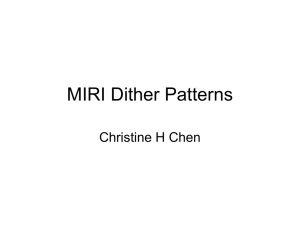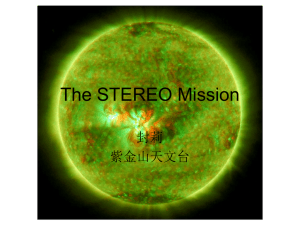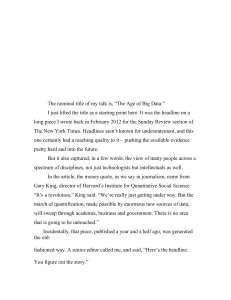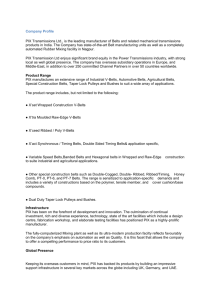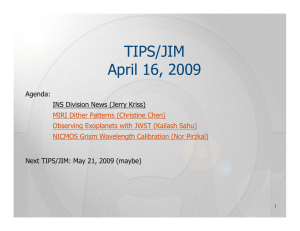MIRI Dither Patterns Christine H Chen
advertisement
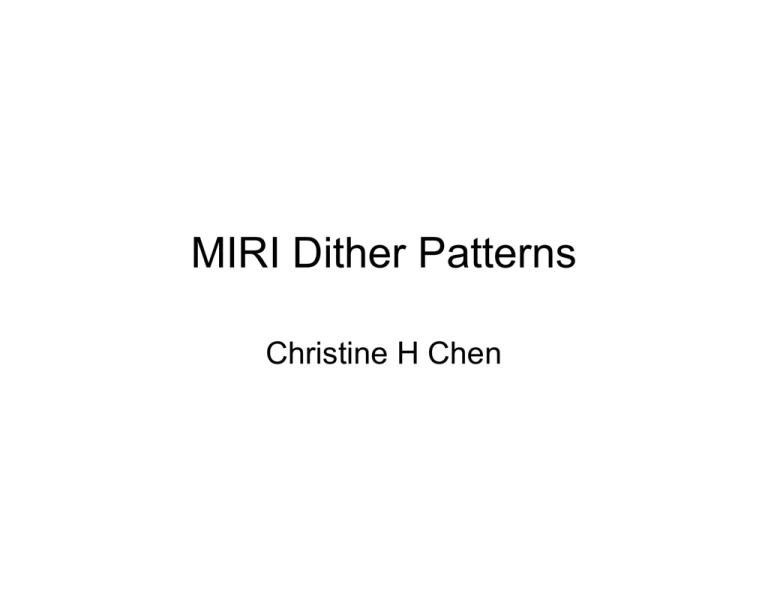
MIRI Dither Patterns Christine H Chen Dithering Goals 1. Mitigate the effect of bad pixels 2. Obtain sub-pixel sampling 3. Self-calibrate data if changing scattered light and/or thermal emission background is significant ⇒ It is anticipated that dithering will enhance the majority of science observations (although some programs will require no dithering) MIRI Observing Modes • Direct Imaging Full array – Subarray × Coronagraphic Imaging Low Resolution Spectrograph (LRS) • Medium Resolution Spectrograph (MRS) MIRI Direct Imaging Specifications • Available Filters: 5.6, 7.7, 10.0, 11.3, 12.8 15, 18, 21, and 25.5 µm • Plate Scale: 0.11″/pixel • Critically sampled at 7 µm • Field of View: 75″x112″ (680x1024 pixels) • Geometric Distortion: <0.9% at array corners Gordon & Meixner 2008 Time-Variable Thermal Background • • • • Telescope thermal emission is expected to dominate the background for λ >15 µm Thermal background is expected to change due to variable telescope illumination as telescope is slewed Self-calibration of deep fields with time-variable pedestals has been demonstrated using NICMOS HDF-N and NDF-S data (Arendt, Fixsen, & Mosley 2002) Propose using 12-point Reuleaux and 311-point random cycling patterns to optimize selfcalibration Reuleaux Triangle • • • Reuleaux polygon is a curve of constant width; the distance between two opposite, parallel, tangent lines to its boundary is constant The Reuleaux triangle optimizes the figure of merit (Arendt Fixsen, & Mosley 2000), samples a wide range of spatial frequencies in a uniform manner, and is therefore wellsuited to the Fixsen leastsquares flat field technique The 36-point Reuleaux triangle has been use in detailed characterization of the IRAC PSF (Marengo et al. 2008) The Random Cycling Pattern • • • • Predetermined table of 311 dither positions The x- and y- offsets from the array center are randomly drawn from a Gaussian distribution with a specified FWHM Observer specifies beginning position and end position in dither pattern Every contiguous 4 offset positions contain 1/2 pixel offsets in each direction Subpixel Sampling • • • • A. Fruchter Since MIRI is not badly undersampled, 0.5 pixel subsampling should be adequate for the majority of science observations Reuleaux and Cycling patterns have 0.5 pixel offsets built-in to provide some subpixel sampling The measured geometric distortion (<0.9% in the corners) implies that 10 pixel offsets in the center of the array will correspond to 10.1 pixel offsets in the corners of the array A 4-point box pattern (0,0),(0,2.5),(2.5,0),(2.5,2.5) will be offered that can be used alone or in conjunction with either the Reuleaux or Cycling Patterns JWST Observatory Offsetting Accuracy • • • Anandakrishnan et al. 2006 Offsets smaller than 0.5′ (270 pixels) do not require use of new guide stars Commanded offsets <10 pixels will have adequate source placement precision (11 mas) for interlacing from 1/2 pixel sub-sampled images at the center of the array Observatory will possess 7 mas jitter while pointed at a fixed position Proposed Direct Imaging Dither Patterns Pattern 4-Pt Box Cycling 12-Pt Reuleaux Scale N/A Small Medium Large Small Medium Large Max Offset 3.5 pix 11 pix 119 pix 161 pix 13 pix 27 pix 55 pix Median Offset 2.5 pix 10.5 pix 53 pix 97 pix 15 pix 30 pix 59 pix Sub-Pixel pix pix pix pix pix pix pix MIRI LRS Specifications • Wavelength range: 5-10 µm nominal (2-14 µm expected) • Slit Dimensions: 0.6″×5.5″ (5x45 pixels) • Spectral Resolution: R=100 at 7.5 µm • Spatial Plate Scale: 0.11″ /pixel • Spectral Plate Scale: 2 pixels/resolution element • Critically sampled (spatially) at 7 µm Gordon & Meixner 2008 Background Subtraction • Simultaneous measurements of the sky are needed to perform background subtraction • PSF size: (1.22λ/D=) 0.54″ at 14 µm, ~1/10th slit length, suggesting that 2 dither positions separated by 1/3 of the slit length should be adequate for background subtraction Proposed LRS Observing Modes • Point Source/Staring Mode • Two dither positions with source near the center of the slit • Extended Source/Mapping Mode • Observer specified dither pattern • Number of slit positions parallel and perpendicular to the slit • The size of the offset in each direction JWST Observatory Offsetting Accuracy • • • Anandakrishnan et al. 2006 Offsets smaller than 0.5′ (270 pixels) do not require use of new guide stars Observatory will possess 7 mas jitter while pointed at a fixed position Commanded dither offsets of 1/3 slit length will place the source onto the detector with 17.1 mas precision (20% precision) adequate for 1/2 pixel subsampling Summary • Direct Imaging (full array) – Subpixel sampling: 4 point box – Self-Calibration: 12 point Reuleaux triangle and random cycling • LRS – Extended Source/Mapping mode – Point Source/Staring Mode Observatory Pointing Efficiency Slew Performance: [Max Accel, Max Rate, T1] =0.0001453 8.19e -005, 0.0539 2 0.036, 60 10 slew capability (6 rwas) slew capability (4 rwas) slew requirement 1 Time To Complete Slew, min 10 0 10 Mitchell 2008 -1 10 -6 10 -5 10 -4 10 -3 10 -2 10 -1 10 0 10 1 10 2 10 3 10 Angle (degrees) • • The slew time for offsets up to 3.6″ (33 pixels) will be 10 sec independent of slew size (4-point box, 12-point Reuleaux, and small Cycling patterns) Larger slews will take exponentially longer times (medium and large Cycling patterns)
